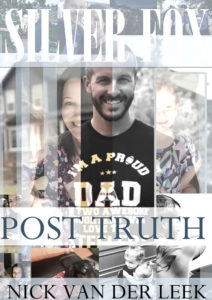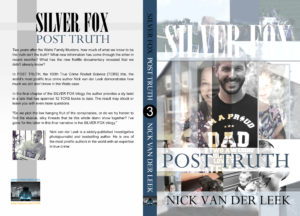A regular reader of this blog and my books recently asked if I was aware of the current coverage of the Zahau case. My response was something long the lines of needing to maintain a single-minded focus on the Watts case. Consistent laser focus and concentrated attention is necessary, naturally, in true crime.
Focus is vital to penetrate the many layers of deceit and misdirection, and figuring out who people really are when they’re purposefully hiding who they are, takes time and effort. But we have to be careful. There’s focus and there’s also the danger of becoming one-track minded. When we’re one-track minded we’re in our own echo chamber and nothing new gets in. When that happens we as individuals, and as a group apparently sharing the same ideas, risk taking the bus to Abeline.
This is where Intertextuality comes in. It’s an incredibly valuable tool in true crime, and useful in criminal trials where – come sentencing – lawyers argue how previous cases were decided on, or how previous felons in similar scenarios were dealt with. Intertextuality is a highway to insights. Through other cases we have a better idea of who and what we are dealing with.
The first time I was truly shaken by the insights of Intertextuality occurred in early June 2018, during the Jason Rohde trial. At the time I’d written about the Zahau case, and so the unusual scenario of a murder staged as a suicide was still fresh in my mind. Sitting in court watching Rohde, listening to the autopsy findings, seeing the crime scene pictures projected in court, and listening to him testify, I saw many of the patterns I’d noticed in the Zahau case come rushing back. In fact I was so transported by these insights I was moved to do something I wouldn’t normally do. During a recess I boldly approached the prosecutor, briefly introduced myself and communicated my intuitions. He wasn’t very receptive. Not at first.
I’m not sure how many people like to be approached like that and told how to do their jobs. A prosecutor instinctively shoots holes into people. So I felt a little like that on Day 1, but as the trial wore on we communicated more often and soon, some of my ideas were floated in court. When the judge delivered her judgment in late February 2019, some artifacts of those ideas were still circulating.
Watts + Packham
In the Watts case it’s easy to get stuck on the idea that Watts didn’t have a plan, and hence, didn’t have an explanation for what happened to Shan’ann. Conversely, if he didn’t have a good explanation, he couldn’t have a good plan. This is circular reasoning, and within the confines of the circle, yes it’s fairly compelling. When we look at the larger ecosystem of the Watts case, the mistress, the pregnancy, the finances, the evidence, the notion that Watts randomly and impulsively committed triple murder becomes absurd.
It’s tempting to conflate Watts’ social awkwardness and introversion with stupidity and lack of guile. What’s really going on is the opposite. His social awkwardness makes him more internalized, which makes him a thinker, a plot, a planner. He likes to be under the radar.
Watts himself said he had to think carefully about what he said to Shan’ann. He had to plan his answers.

Over the course of a marriage, where one individual can’t be who they really are, they practice their deceits and soon misdirection becomes second nature. As the deceits become more elaborate, such as an affair, so does the strategy, plotting and planning around it. The affair is the first thing “he gets away with” and this gives him confidence that he’s good at getting away with things. But he has to become more sophisticated and so a plot is hatched. And with enough arrogance and frustration, mendacity graduates into murder.
When we look at Packham, we see a wealthy individual, and an intelligent businessman. Nothing like Chris Watts, right? Actually, besides the money, they’re not so very different.
Packham had been married to his wife for almost thirty one years, but the couple had been having marital problems because of his infidelities, before her disappearance on February 22, last year. She did not arrive for work at the usual time of 7.30am and her body was later found in the boot of her burnt-out BMW near the Diep River train station.
Steyn rejected Packham’s version that she could have been the victim of a random hijacking and instead found that Packham was “a crafty deceiver”, agreeing with the State that his conduct was “incomprehensible” and had been indicative of guilt. – The Citizen
Like the Watts Family Murders, Packham’s wife was made to disappear. But unlike the Watts Family Murders, Gill Packham’s disappearance wasn’t “invisible”. Instead of oil tanks her remains were burnt inside her vehicle near a train station in a derelict suburb far from their lush mansion in Constantia. The incineration of the vehicle was meant to conceal the blunt force injuries to her head, but also to destroy possible DNA evidence linking Packham to his wife’s corpse.
On paper, Packham’s explanation isn’t bad. Packham suggested that his wife had come to grief as a result of a random hijacking. This is fairly common in Cape Town, so why not? Well, one reason is hijackers seldom burn the vehicles they target. In this case it was a BMW, so why would a hijacker burn the vehicle and not just take it? Packham didn’t think it through because he didn’t think he needed to. Who knows the motives of random hijackers…?
We may look at that kind of simplistic thinking as daft, but we’re not seeing the full picture. We don’t know the underlying drivers and dynamics, and we don’t know about Packham’s relationships with others, including his children. [The same applies to Rohde].
Interestingly in both the Rohde trial and the Packham trial, the daughters of the accused immediately forgave their fathers, and despite the convictions for the murders of their mothers [respectively], they didn’t want their fathers to be sentenced too harshly.



In the Watts case we see the same expression of clemency and forgiveness not only from his own parents, but from the Rzuceks as well. It’s as if he did the calculations beforehand and figured if they found out, they’d let him get away with it.
And what about the lack of remorse? Packham and Rohde also showed no remorse, but interestingly Rohde, when confronted with this, indicated that showing remorse would look like admitting guilt.

Guilty murderers don’t seem to realize that even an innocent defendant would be concerned and traumatized by the death of someone so close to them, besides being emotional about being “wrongly implicated” in a crime. Instead the lack of emotion is meant to convey blamelessness. It works only in the mind of the one who is to blame, but it can work in the minds of those close to them as well.

He had not once mentioned that he missed his wife or felt sympathy for his children’s loss, and instead displayed a “dismissive attitude” in court that lacked empathy. Judge Steyn said Packham had not divulged a motive, but it appeared he killed his wife out of “anger and frustration”.
Of course once again we have a case where after all is said and done, the guilty man is convicted, but no one can say why. The crime is ultimately dismissed as a crime executed in anger. He’s angry but he’s a sociopath who shows no remorse. Really? Is he? Was it random frustration on a random day or was it cold, premeditated and merciless?
Which is worse?












Recent Comments